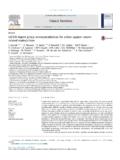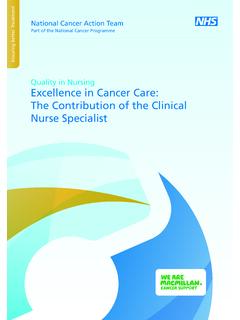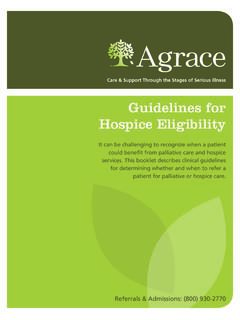Transcription of Lab Test Interpretation Table - BC Cancer
1 Lab Test Interpretation Table * Normal Range** Interpretation Tips Hematology White Blood Cell Count (WBC) & Differential Leukocytes/WBC 4 10 x 109 /L Neutrophils - Absolute Neutrophil Count (ANC) = 2 x 109/L - Calculated ANC = WBC x (segs+bands) / 100 - Band neutrophils: < x 109/L Basophils < x 109/L Eosinophils < x 109/L Lymphocytes = 1 4 x 109/L Monocytes = x 109/L WBCs are measured as part of a complete blood count and differential (CBC & diff). They protect the body from infection.
2 Increased Counts - Leukocytosis and neutrophilia can be caused by infection, myeloproliferative disorders, inflammation, and medications. o In Cancer patients, supportive medications such as corticosteroids and colony stimulating factors can cause elevated counts. Treatment is not required unless they are associated with bone pain, which may improve with analgesic therapy. o When leukocytosis is accompanied by increased immature neutrophils (band neutrophils) and fever, infection is a likely cause. Band neutrophils often increase in number to fight infections (also called a shift to the left ).
3 - Elevated lymphocyte counts are associated with increased risk of cytokine-release syndrome (see BC Cancer Protocol LYCHOPR) or tumour lysis syndrome (see BC Cancer Protocol ULYVENETO) and prophylaxis may be indicated. Consult respective protocol and/or tumor group chair for management recommendations. Decreased Counts - Leukocytopenia and neutropenia can result from nutritional deficiency, autoimmune disease, bone marrow infiltration ( , leukemia or myelodysplastic syndrome), radiation, and myelosuppression due to medications (including many Cancer drugs).
4 O Many treatment protocols require dose adjustments or the addition of colony stimulating factors ( , filgrastim) if ANC drops below x 109/L. Some protocols tolerate lower thresholds. - Febrile neutropenia is defined as the presence of neutropenia plus concurrent fever (ANC < 1 x 109/L and single oral temperature of orally or a temperature of 38oC over 1 h). It is a medical emergency which requires treatment with antibiotics +/- supportive medications. Normal Range** Interpretation Tips Platelets (Thrombocytes) 150 400 x 109/L Platelets are measured as part of a complete blood count (CBC).
5 They are involved in blood clotting. Increased Counts - Thrombocytosis can be caused by bone marrow disorders, various cancers, inflammatory disease, or surgical removal of the spleen. o In patients with myeloproliferative disorders, thrombocytosis is generally caused by the malignancy. o In patients without myeloproliferative disorders, it is prudent to notify the prescriber if thrombocytosis occurs. Treatment is generally not required unless the patient is symptomatic. Decreased Counts - Thrombocytopenia can be caused by bone marrow disorders, bone marrow infiltration ( , leukemia, lymphoma), viral infections, or Cancer drug therapy and radiation.
6 O Many protocols require a dose reduction or delay if platelet count is < 100 x 109/L. Some protocols tolerate lower thresholds. o If the thrombocytopenia is disease-related, no dose change may be necessary. Red Blood Cells (RBCs, Erythrocytes) Females: 5 x 1012/L Males: x 1012/L Hemoglobin (Hgb) Females: 115 155 g/L Males: 135 170 g/L RBCs are measured as part of a complete blood count (CBC). They use hemoglobin (Hgb) to help deliver oxygen to body tissues. Increased Counts - Erythrocytosis and hemoglobinemia can occur to compensate for low oxygen levels (heart disease, lung disease, high altitude), or may be caused by other conditions such as polycythemia vera, dehydration, and kidney tumours that produce excess erythropoietin.
7 Decreased Counts - Decreased Hgb and RBCs can result from chronic anemia, blood loss (hemorrhage, hemolysis), nutritional deficiency, bone marrow disorders, Cancer , or medications (including many Cancer treatment drugs). Liver Function Tests (LFTs): for Synthetic Ability Albumin 35 50 g/L Albumin is a protein synthesized by the liver and can be an indicator of the liver s synthetic ability. However, because it has a long half-life of 20-30 days, and levels often remain normal even in acute Normal Range** Interpretation Tips disease, it is not always useful in assessing acute hepatic injury.
8 - Decreased albumin levels can occur in chronic diseases such as cirrhosis, Cancer and malnutrition. Prothrombin Time (PT) seconds International Normalized Ratio (INR) seconds (normal) Partial Thromboplastin Time (PTT) 60 70 seconds Activated Partial Thromboplastin Time (aPTT) 30 - 40 seconds The liver is responsible for synthesizing a number of different clotting factors. Unlike albumin, PT offers a good reflection of acute changes in liver function because of the short half-life of clotting factors. PT may be reported as a standardized INR value or tested in conjunction with partial thromboplastin time (PTT) or activated partial thromboplastin time (aPTT).
9 - Liver damage can significantly prolong clotting time ( , PT) and increase the risk of bleeding. o PT may rise to 50 sec or greater in acute liver failure. o PT is usually 2 to 5 times the upper limit of normal (ULN) in cirrhosis. - INR, PT, PTT and aPTT times may deliberately be kept longer, at to times the normal value, for patients on anticoagulant therapy or patients with artificial heart valves. - Other factors that can prolong PT include vitamin K deficiency (an essential co-factor in the clotting cascade), inherited clotting factor deficiencies and certain types of leukemia.
10 Liver Function Tests (LFTs): for Hepatocellular Injury Alanine aminotransferase (ALT) Females: <36 U/L Males: <50 U/L ALT is an enzyme found primarily in hepatocytes, but also in the skeletal muscle, heart and kidneys. It is a useful marker of hepatic injury. - ALT is released into the blood when the liver is damaged or inflamed. Liver Cancer or liver metastases may elevate ALT. - ALT is higher than AST (aspartate aminotransferase) in most types of liver disease ( , AST/ALT ratio < 1). - Very high ALT levels (> 1000 U/L) are most commonly due to viral hepatitis, ischemic hepatitis, or liver injury due to drug or toxin.















